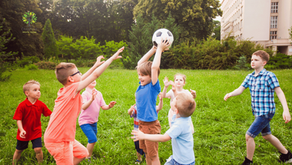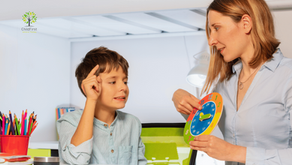10 Engaging Indoor Activities To Promote Learning In Kids With Autism
- ChildFirst Behavior Therapy

- Oct 5, 2023
- 6 min read
Updated: Dec 12, 2023

Engaging them in indoor activities can effectively promote learning and development while catering to their requirements.
Let’s take a look at the ten engaging indoor activities tailored for children with autism, focusing on their cognitive, social, and sensory development.
These activities aim to provide a supportive environment for children with autism to thrive and grow.
Sensory Play with Homemade Sensory Bins
Sensory play is crucial for children with autism, as it helps them develop sensory processing skills and regulate their sensory sensitivities.
Create sensory bins filled with materials like rice, beans, or sand, and add textured objects, toys, and items with various colors and shapes to stimulate their senses.
Encourage your child to explore and interact with these bins, promoting sensory exploration and fine motor skills.
Visual Schedules and Social Stories
Visual schedules and social stories are practical tools to help children with autism understand and anticipate daily routines and social situations.
Using pictures, symbols, or written words, create schedules or stories that guide them through tasks, transitions, or social interactions.
These visual supports can provide clarity and reduce anxiety, enhancing their learning experience.
Visible schedules are conducive for children with autism as they offer a clear structure and predictability in their day-to-day lives.
Interactive Games and Puzzles
Engage your child's cognitive and problem-solving skills with interactive games and puzzles.
Choose age-appropriate board games, jigsaw puzzles, or educational apps that align with their interests and abilities.
These activities encourage critical thinking, turn-taking, and social interaction while providing an enjoyable learning experience.
Games and puzzles can provide structured opportunities for children with autism to learn important social skills such as sharing, waiting, and taking turns.
Art and Creativity
Art and creative activities hold a special place in the hearts of all children, including those with autism.
These activities offer a unique avenue for self-expression, emotional regulation, and skill development.
Let's delve deeper into the world of art and creativity and explore how you can harness their potential to benefit your child with autism.
1. Self-Expression Through Art:
Art allows children with autism to communicate thoughts, feelings, and experiences that may be challenging to express verbally.
They can create visual representations of their inner world through drawing, painting, or sculpture.
This process provides an emotional outlet and a valuable glimpse into the thoughts and emotions of parents and caregivers.
2. Sensory Exploration:
For many children with autism, sensory sensitivities are a part of their daily life.
Art activities can be adapted to accommodate these sensitivities.
Experiment with different art materials like soft pastels, watercolors, or clay.
Please encourage your child to explore the tactile sensations of these mediums, helping them become more comfortable with various textures and temperatures.
3. Boosting Fine Motor Skills:
Art activities like drawing or using scissors to cut paper can significantly enhance fine motor skills.
These activities promote hand-eye coordination, precision, and control over hand movements.
Improved fine motor skills can positively impact a child's ability to perform everyday tasks, such as buttoning clothes or writing.
4. Encouraging Creativity:
Art encourages children with autism to think outside the box and explore their creativity.
Provide an array of art supplies and encourage experimentation.
Please let them mix colors, try different techniques, and create unique masterpieces.
This fosters a sense of autonomy and self-confidence.
6. Supporting Communication:

Art activities may serve as a bridge for communication between you and your child.
They may use art to convey their thoughts, preferences, or interests.
Please pay close attention to their artwork; it can provide valuable insights into their world and serve as a starting point for conversations.
7. Collaborative Creativity:
Art can also be a social activity.
Encourage your child to create art alongside you or with peers.
Collaborative projects promote social awareness, communication, and sharing.
Additionally, it allows your child to practice social skills in a relaxed and enjoyable setting.
Sensory-Friendly Cooking
Cooking is a sensory-rich activity that can be adapted to accommodate children with autism.
Involve your child in simple cooking tasks like measuring ingredients, mixing, or decorating cookies.
The sensory experiences of touching, smelling, and tasting can be educational and enjoyable, promoting independence and life skills.
Sensory-friendly cooking activities help children with autism become more comfortable with different textures and smells, which can benefit their daily routines.
Music and Dance
Many children with autism have a natural affinity for music.
Explore musical activities like singing, dancing, or playing musical instruments.
Music can help improve emotional expression and coordination while providing a fun and engaging outlet for self-expression.
Building and Construction
Building and construction toys like LEGO sets or building blocks offer children with autism the opportunity to enhance their spatial awareness, creativity, and problem-solving skills.
Please encourage them to build structures, vehicles, or imaginative worlds, fostering fine and gross motor skills.
Building activities are a fantastic way to promote creativity and fine motor skills, allowing children with autism to express themselves through construction.
Storytelling and Role-Playing
Storytelling and role-playing activities stimulate imagination and social development.
Use toys, puppets, or action figures to create scenarios and encourage your child to narrate stories or act out various roles.
This promotes language development, creativity, and social interaction.
Storytelling and role-playing can also help children with autism practice and improve their conversational and social skills.
Sensory-Friendly Reading Nooks
Create a cozy and sensory-friendly reading nook in your home.
Fill it with soft pillows, comfortable seating, and books that cater to your child's interests and reading level.
Reading together enhances their literacy skills and provides a calming and enjoyable sensory experience.
Reading can be an excellent way to bond with your child and create positive associations with books and learning.
Sensory Exploration with Playdough
Playdough is an excellent medium for sensory exploration and fine motor skill development.
Make or purchase playdough in different colors and scents.
Please encourage your child to mold shapes, patterns, and imaginative creations, stimulating their creativity and tactile senses.
Playdough activities can help children with autism become more comfortable with different textures and sensations, contributing to their sensory development.
Conclusion
Engaging children with autism in indoor activities tailored to their unique needs can promote learning and development while fostering a sense of accomplishment and self-esteem.
These ten activities, ranging from sensory play to storytelling, provide a well-rounded approach to addressing various aspects of a child's development.
By creating a supportive and stimulating environment, parents and caregivers can help children with autism thrive and reach their full potential.
Remember that every child with autism is different, so it's essential to adapt and customize activities to suit their strengths and challenges.
At Child First Behavior Therapy, we're dedicated to making a lasting impact on the lives of children with autism.
We recognize the diversity among children with autism, and that's why our strategies are not one-size-fits-all.
Every child is unique, with distinct strengths and challenges, and we take pride in customizing our therapies to suit their individual needs.
Child First Behavior Therapy is more than a service; it's a partnership.
We're here to help your child thrive and reach their full potential, fostering an environment where each achievement becomes a stepping stone toward a brighter future.
FAQs
What is an autism spectrum disorder (ASD)?

Autism spectrum disorder (ASD) is a developmental disorder characterized by challenges in social communication and repetitive behaviors. It encompasses various abilities and symptoms, each unique in their experiences. Understanding the spectrum is crucial to tailoring activities to your child's needs.
Why are indoor activities important for children with autism?
Indoor activities provide a controlled and safe environment for children with autism to learn and develop. They can help improve social skills and cognitive abilities while minimizing sensory overload. Creating a comfortable and supportive indoor space for your child is essential.
How can I create a sensory-friendly environment at home?
You can create a sensory-friendly environment by minimizing sensory distractions, providing sensory tools like fidget toys, and using soft lighting and calming colors in your home.
What are social stories, and how do they benefit children with autism?
Social stories are visual tools that help children with autism understand social situations and expectations. While they do not reinforce your child’s ability to react appropriately in a social setting, they do provide instruction and a platform to engage your child in conversation and potentially role-playing opportunities. In this way, they can make social interactions more predictable and manageable.
Social stories should be personalized to your child's unique challenges and interests.
Are there specific art activities that are better for children with autism?
The quick answer is no. However, art activities that involve tactile exploration, such as finger painting or sculpting, can be particularly engaging for some children with autism.
These activities promote sensory exploration and self-expression.
Experiment with different art mediums to find what your child enjoys the most.
How can I support my child's interest in music if they have autism?
Please encourage your child's interest in music by providing access to musical instruments, singing together, or enrolling them in music therapy programs.
Music may help with emotional regulation and communication, and you can adapt music activities to suit their sensory preferences.
What types of building toys are suitable for children with autism?
Building toys like LEGO sets, Mega Bloks, or wooden building blocks are just a few examples of building toys that are suitable for children with autism. These toys promote fine motor skills, spatial awareness, and creativity.
You can also use building activities as opportunities for collaborative play and social engagement.
How can storytelling and role-playing activities benefit my child with autism?
Storytelling and role-playing activities can enhance your child's language skills, imagination, and social interaction.
They provide a structured way to practice communication and empathy, and you can tailor scenarios to address specific social challenges your child faces.
How do I make a reading nook sensory-friendly for my child with autism?
Choose comfortable seating, soft textures, and calming colors to make a sensory-friendly reading nook.
Include books that cater to your child's interests and sensory preferences, such as tactile or interactive books.
Create a cozy and inviting space that encourages them to explore the joy of reading.










Comments